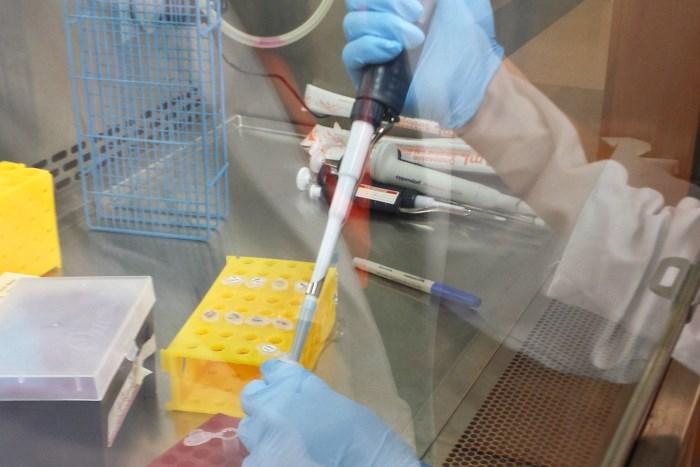Daisies and Cancer Research

Photo by Tony Moore
Student-faculty collaboration explores leukemic stem cells
by Tony Moore
Assistant Professor of Chemistry Rebecca Connor began her current project, Identification of Proteins Modified by Parthenolide Derivatives in Leukemic Stem Cells, as soon as she came to Dickinson in 2010. Not far behind was Myungsun Shin '14, who, as a first-year student, asked if he could work with her during the summer of 2011.
"One great thing about this project," Connor says, "is that it involves cell biology, chemistry, organic chemistry … Shin's gotten really good at chemical synthesis."
The pair has worked on the project since 2011 through the school years and during breaks, except the summer of 2012, when Shin was back home in South Korea. (While Shin has been the constant, others, such as Gabriel DiNatale ’14, Terence Cai ’13 and Thanprakorn Chiramanewong ’13, have pitched in on the project along the way as well.)
This summer, Connor and Shin hope to complete the research, which explores parthenolide—a chemical compound that comes from feverfew (aka daisies). Used by traditional herbalists to treat fevers, the compound has tried-and-true anti-inflammatory properties. It also has recently been shown to affect leukemic stem cells, which cause leukemia to recur. This is where Connor's and Shin's research comes in.
"If you can kill those cells, you can stop the recurrence and you can have a true cure," Connor says. "What we don't know is exactly why. Why does it affect the leukemic stem cells more than regular cells? Is there a signature, a fingerprint, of what proteins it modifies?"
Searching for answers has also helped Shin round out his classroom experience. "In the classes I've been taking in organic chemistry and biology," he says, "you don't always know how the material is being used in writing the literature, but by working on this project, I can better understand all the materials that I've learned in class."
When the project wraps up, the pair hopes to publish their results and to make a valuable contribution to a growing body of scientific data.
"We're not going to be making cancer drugs," Connor says, "but any new knowledge we can give to the community can be used toward it."
Read more:
Student-faculty research
The project's abstract:
Some chemotherapeutic drugs are natural products of plants or microorganisms. Parthenolide is a molecule made by the plant feverfew that has been shown to selectively kill leukemia stem cells; however, its mode of action is not fully understood. We have synthesized derivatives of parthenolide and we will use these derivatives to identify the proteins in leukemia cells targeted by this molecule. Through these experiments, we will gain an understanding of the action of parthenolide in biological systems and its potential targets in leukemic stem cells. It is the interaction with potential targets that gives rise to the potency of parthenolide and parthenolide derivatives as anti-cancer agents.
Published July 19, 2013